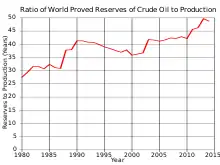Oil constant
Ölkonstante (oil constant in German) is a term describing various material properties of (vegetable and mineral) oils.[1] The term Erdölkonstante (crude oil constant in German) has been used as well an inside joke and pun in the German petroleum industry.
Background

It refers to the constant estimate of available petroleum (Erdöl in German) reserves to production ratio R/P. The estimated duration until the available petroleum reserves are depleted at current production has remained around 40 years since the late 80s.[2] Prewar and immediately postwar estimates were sometimes lower, in 1919 as low as 9 years (USA) and in 1948 around 20 years (world) and rose til 35 years until the 70s.[3] However, since then the duration value T=R/P has been rather constant for decades despite rising oil consumption.
One factor contributing to the apparent constancy of the R/P ratio is a neglect or misunderstanding of the fact that the term "proven reserves" does not refer to some absolute quantity of remaining oil that is thought to exist, but rather to the quantity of oil that can be economically extracted given the current price of oil and current oil-extraction technologies. Thus, either an increase in the price of oil or improvements in oil-extraction technologies can lead to an increase in the estimate of "proven reserves" since more-expensive-to-mine deposits such as tight oil become economically viable at a higher oil price, and because newer or more expensive enhanced oil recovery processes such as gas injection, steam injection, and hydraulic fracturing allow continued extraction of oil from fields that would have been considered worth to abandon at a lower price or using older technologies. Thus, it is possible for the "proven reserves of oil" (i.e., economically extractable reserves of oil) to keep pace with or even pull ahead of oil consumption at the current rate.[4]
On the other hand, the reserves to production ratio is only one mathematical indicator for the geological inventory. More important than the size of the tank is the production rate (e.g. the size of the spigot of a barrel), and with many capital-intensive technologies for extracting oil from non-conventional sources, also the flow rate is getting smaller.
Analogous use
A similar pun has been used about the feasibility of fusion power: Since the 1950s, feasible technological means of using fusion for electricity production have constantly been predicted as being 30–40 years ahead, so the "fusion constant" exhibits a similar range to the "oil constant".[5]
References
- E. Matthes: Theoretische Betrachtungen über die Ölkonstanten als Maßstab für die Veränderungen von ölen während des Keimens der Samen. (Bot. Arch., 18, 1927, 269—281).
- "Statistical Review of World Energy 2020" (PDF) (69 ed.). BP. June 2020. p. 15. Retrieved 2021-01-20.
Reserves-to-production (R/P) ratios, History
- Maugeri, Leonardo (2004-05-21). "Oil: Never Cry Wolf – Why the Petroleum Age Is Far from over". Science. 304 (5674): 1114–1115. doi:10.1126/science.1096427. Retrieved 2021-01-17.
- Alahdal A. Hussein, "Oil Reserves And The Public Misconceptions", Oil + Gas Monitor, 15 January 2016
- Ulf von Rauchhaupt, "Sonnenfeuer am Boden", Die Zeit, 15 April 1999.